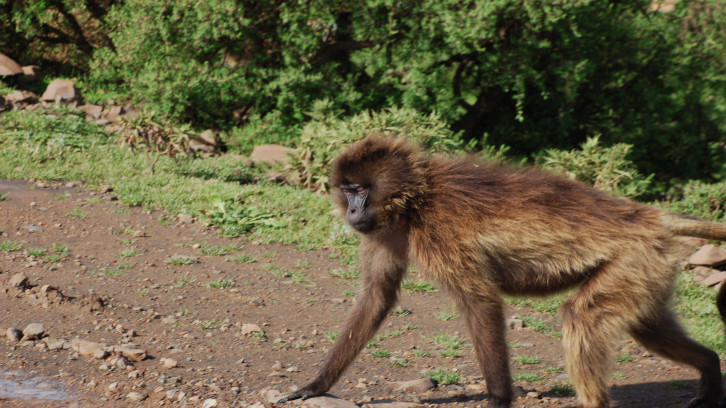Analysis of the paleodiet of Theropithecus oswaldi from Cueva Victoria (Cartagena), a fossil papionini from the Lower Pleistocene

The Theropithecus oswaldi primate undertook a wide geographic expansion 4.1 million years ago, before becoming extinct during the Pleistocene, and left an abundant fossil record. The remains found in Cueva Victoria (Cartagena) can help researchers gain more in-depth knowledge of ecological adaptations, as well as the reasons for their extinction, their migratory routes and colonization processes. In this study, carried out by researchers from the Unitat d'Antorpologia Biològica from UAB and the Unitat de Zoologia i Antropologia from UB, the diet of these extinct primates has been reconstructed by comparing it with that of the only baboons alive today in the Ethiopian mountains, the T. gelada.
4.1 million years ago, in the region of present-day Kenya, a new genus of catarrhine primate, Theropithecus, suddenly appeared in the African fossil record. The evolutionary history of this genus is surprising as it became the most abundant primate in the fossil record during the Pleistocene (0.5 Ma) to end up suffering an almost total collapse, probably displaced by a new catarrhine genus, Papio, originated in South Africa and with greater dietary versatility.
Theropithecus showed a remarkable geographical expansion beyond the Sahara Desert. Thus, T. oswaldi performing an Out of Africa (i.e., the process of migration and expansion of populations outside Africa) arrived in Eurasia, in parallel with the genus Homo. Fossil remains of Theropithecus have been recovered in Israel and India, on the one hand, on a possible route out of Africa, and in the Maghreb and southern Iberian Peninsula (at the Victoria Cave site, Cartagena), on the other possible expansion route. Despite this, during the Pleistocene, Theropithecus oswaldi disappeared almost completely. Currently, only one species of the Theropithecus, T. gelada, remains, confined to high mountain environments in Ethiopia, such as the Simien Mountains Natural Park.
The paleontological remains of T. oswaldi from Victoria Cave have a paleontological interest inherent in being the only ones recovered on the European continent. Therefore, their study can help us to delve deeper into the ecological adaptations of this species and, eventually, to be able to hypothesize the reasons for its subsequent extinction. In addition, they can provide information on migrations and the processes of colonization of African fauna across the Mediterranean. In order to characterize the diet of T. oswaldi remains from Cueva Victoria, the buccal microwear pattern of the postcanine dentition (premolars and molar) was analyzed.
Microwear studies are based on the statistical analysis of the stretch marks that certain particles present in the food bowl leave in the enamel during the chewing process. These are usually phytoliths, that is, silica particles with a structural function found in plants (with a hardness index on the Mohs scale higher than that of tooth enamel). However, the incorporation of extrinsic elements into food, such as sand or dust, can also cause microstriations during the chewing process. In order to interpret the buccccal microwear pattern of T. oswaldi, it was compared with that of a set of extant catarrhal primates of known diet.
The results of the study indicate that T. oswaldi shows a microwear pattern similar to that of other extant frugivorous species such as Mandrillus sphinx or mangabeys (Cercocebus sp.), both species adapted to hard foods and that inhabit semi-open environments of forests and savannas. The most striking fact, however, is the dietary difference observed between the fossil species T. oswaldi of Cueva Victoria and the extant T. gelada from the Ethiopian mountains. This difference would indicate that the fossil species of Cueva Victoria would have had a broader diet than T. gelada, a possible adaptation to address climate change affecting Eurasia about 1.0 Ma ago.
The next step in the Paleobaboon project is precisely to compare the buccal microwear pattern T. oswaldi from Cueva Victoria with that of other Theropithecus specimens recovered in North Africa, to be able to check whether they had similar dietary adaptations.
Universitat Autònoma de Barcelona (UAB).
Universitat de Barcelona (UB)
1Zoology and Anthropology Unit, BEECA Department, Faculty of Biology (UB).
2Anthropology Unit, BABVE Department, Faculty of Biosciences (UAB).
References
Martinez, L.M .; Estebaranz-Sánchez, F .; Ferràndez-Cañadell, C .; Romero, A .; Ribot, F .; Galbany, J .; Gibert, L .; Pérez-Pérez, A. Buccal dental-microwear and feeding ecology of Early Pleistocene Theropithecus oswaldi from Cueva Victoria (Spain). Journal of Human Evolution (2020): 142 https://doi.org/10.1016/j.jhevol.2019.102736


